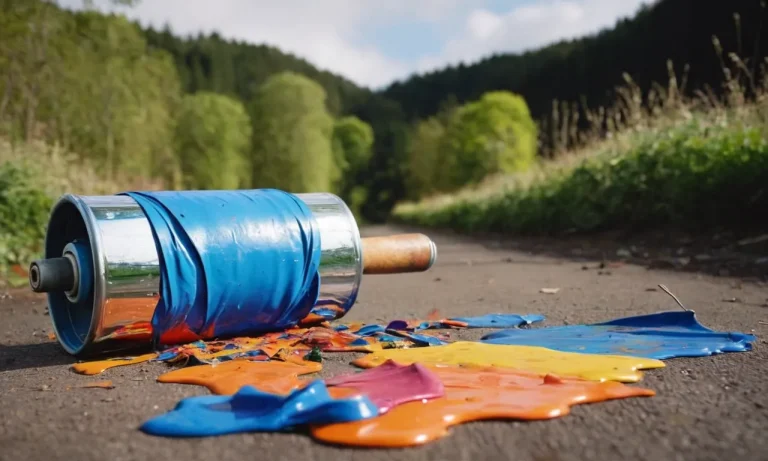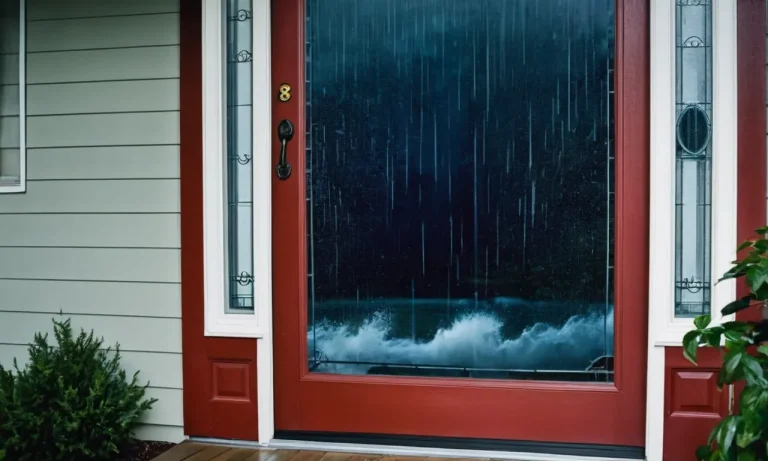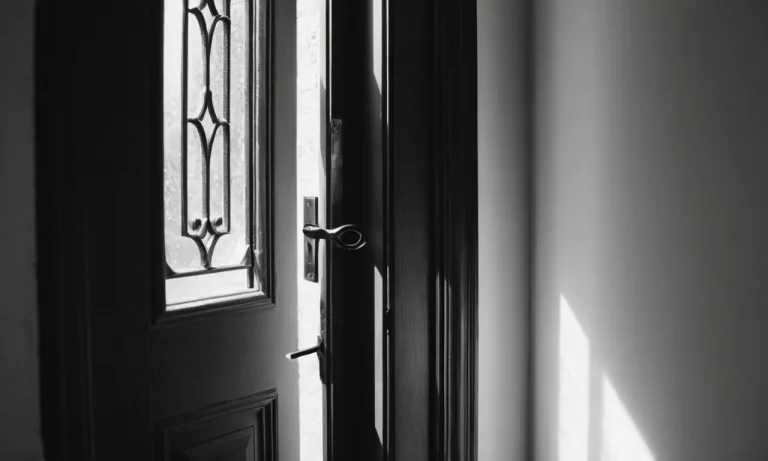How To Clean A Paint Tray Thoroughly
If you’ve just finished a big paint job, you’re probably staring at a paint-caked tray and wondering how to clean it. Paint trays can be tricky to clean, especially if the paint has had time to dry. But with the right techniques and products, you can get that tray looking like new again.
If you need a quick answer: Fill the paint tray with hot water and dish soap, use a plastic scraper to remove big chunks of paint, then scrub with a wire brush. For dried-on paint, cover with oven cleaner and let sit before scrubbing.
In this comprehensive guide, we’ll walk through all the steps and tools you need to clean acrylic, oil-based, and latex paint from a paint tray. You’ll learn how to soften and remove fresh and dried paint, what cleaners work best, and how to care for your paint tray so it lasts job after job.
Gather the Right Cleaning Supplies
Fill sink or tub with hot water
Before you start cleaning your paint tray, it’s important to gather all the necessary cleaning supplies. One of the first things you’ll need is a sink or tub filled with hot water. Hot water helps to loosen the dried paint and makes it easier to remove from the tray.
Fill the sink or tub enough to fully immerse the paint tray.
Dish soap or TSP cleaner
To effectively clean your paint tray, you’ll need a cleaning agent. You can use dish soap or a trisodium phosphate (TSP) cleaner. These cleaning agents help to break down the paint and remove any stubborn stains.
Simply apply a small amount of dish soap or TSP cleaner to the paint tray and scrub it with a brush or sponge.
Plastic or metal scraper
A plastic or metal scraper is essential for removing any dried or excess paint from the tray. Gently scrape off the paint using the scraper, being careful not to damage the tray. This will help to remove any large chunks of paint before proceeding with the cleaning process.
Wire brush
A wire brush can be used to remove any stubborn paint residue or stains from the paint tray. Gently scrub the tray with the wire brush to loosen the paint and make it easier to clean. Be sure to use a brush with soft bristles to avoid scratching the surface of the tray.
Sandpaper
If there are any dried paint drips or rough areas on the paint tray, you can use sandpaper to smooth them out. Gently sand the affected areas until they are smooth and even. This will help to ensure a clean and flawless paint tray for future use.
Oven cleaner
If your paint tray has stubborn stains or dried paint that is difficult to remove, you can try using an oven cleaner. Oven cleaners are designed to break down tough stains and grease, making them effective for cleaning paint trays.
Follow the instructions on the oven cleaner’s packaging and use it with caution, as some oven cleaners may be harsh on certain materials.
Protective gloves
When handling cleaning agents or using a scraper, it’s important to protect your hands. Wear protective gloves to shield your skin from any potential irritants or chemicals. This will help to keep your hands safe and prevent any skin reactions.
Remember, having the right cleaning supplies is crucial for thoroughly cleaning your paint tray. By following these steps and using the appropriate tools, you can ensure that your paint tray is ready for its next use.
Remove Excess Wet Paint
Removing excess wet paint from a paint tray is the first step in thoroughly cleaning it. Here are a few methods to remove the excess paint:
Subheading: Pour out liquid paint from tray
Start by carefully pouring out any remaining liquid paint from the tray. Tilt the tray slowly to prevent spills and avoid splattering paint. You can pour the paint back into the paint can or a separate container for later use.
This step will help reduce the amount of paint you need to clean off the tray.
Subheading: Use scraper to lift off blobs and skins of paint
After pouring out the liquid paint, use a scraper or a putty knife to lift off any blobs or skins of paint that may be stuck to the tray. Gently scrape the surface of the tray to remove these dried paint remnants. Be careful not to scratch or damage the tray while doing so.
Subheading: Rinse tray with hot water
Once you have removed the excess wet and dry paint, it’s time to give the tray a thorough rinse. Fill a sink or bucket with hot water and immerse the tray completely. Let it soak for a few minutes to loosen any remaining paint particles.
Then, use a sponge or a brush to scrub the tray, paying attention to the corners and edges. Rinse the tray with clean hot water to remove all traces of paint.
Remember to wear gloves and protective clothing while cleaning the paint tray, especially if you are working with oil-based paints. Dispose of any leftover paint and cleaning materials responsibly according to your local regulations.
For more detailed instructions and tips on cleaning paint trays, you can visit websites like Family Handyman or Bob Vila.
Scrub Away Remaining Paint
When it comes to cleaning a paint tray thoroughly, scrubbing away any remaining paint is an essential step. Here are some tips to help you get the job done effectively:
Make a cleaning solution of hot water and dish soap
To start, create a cleaning solution by mixing hot water and dish soap in a bucket or basin. The hot water will help loosen the paint, while the dish soap will provide the cleaning power needed to remove any stubborn residue. Make sure to use a generous amount of dish soap for best results.
Use a wire brush to scrub paint residue
Once you have your cleaning solution ready, dip a wire brush into the mixture and use it to scrub the paint tray. Focus on the areas where paint residue is still present, using firm but gentle strokes. The wire bristles will help break up the paint, making it easier to remove.
Rinse and check for leftover paint
After scrubbing, rinse the paint tray with clean water to remove any soap residue. Then, carefully inspect the tray to see if there are any remaining traces of paint. Look for any dried or hardened spots that may require additional attention.
Repeat scrubbing if needed
If you find any leftover paint after rinsing, don’t worry. Simply repeat the scrubbing process using the cleaning solution and wire brush. Sometimes, persistent paint stains may require a bit more effort to completely remove. Be patient and thorough in your scrubbing to ensure a clean paint tray.
Remember, a clean paint tray is essential for achieving smooth and even paint application. By following these steps and giving your paint tray a thorough scrub, you’ll be ready to tackle your next painting project with confidence!
Deal with Dried-On Paint
When it comes to cleaning a paint tray, dealing with dried-on paint can be a daunting task. However, with the right approach and a little bit of elbow grease, you can get your paint tray looking brand new again. Here are some effective methods to deal with dried-on paint:
Fill tray with hot water and let soak
One of the easiest ways to loosen dried-on paint from a paint tray is by filling it with hot water and letting it soak for a while. The hot water helps to soften the paint, making it easier to remove. Let the tray sit in the hot water for about 30 minutes to an hour, depending on how stubborn the paint is.
Scrape away any loosened paint
After the paint has had a chance to soften in the hot water, use a scraper or a putty knife to carefully scrape away any loosened paint. Be gentle to avoid damaging the tray, but firm enough to remove the paint effectively.
You can also use a toothbrush or an old toothbrush to reach into the corners and crevices of the tray.
Apply oven cleaner and let sit for 15 minutes
If there are still remnants of dried-on paint, you can try using oven cleaner to break down the paint further. Apply a generous amount of oven cleaner to the affected areas of the tray and let it sit for about 15 minutes.
The chemicals in the oven cleaner will help to soften the paint, making it easier to remove.
Scrub with wire brush
After the oven cleaner has had a chance to work its magic, use a wire brush to scrub away the remaining paint. The bristles of the wire brush will help to dislodge any stubborn paint particles and make it easier to remove. Be sure to scrub in circular motions to cover the entire surface of the tray.
Rinse thoroughly
Once you have scrubbed away all the dried-on paint, rinse the paint tray thoroughly with clean water. Make sure to remove any traces of the oven cleaner and any remaining paint particles. You can use a hose or a sink to rinse the tray, ensuring that all the cleaning agents are completely removed.
Cleaning a paint tray thoroughly may require some effort, but it is essential for maintaining its longevity and ensuring optimal performance for future painting projects. By following these steps, you can easily deal with dried-on paint and have a clean paint tray ready to use for your next project.
Remove Tough Spots and Stains
When it comes to cleaning a paint tray thoroughly, one of the biggest challenges is removing tough spots and stains. Fortunately, there are several effective methods you can try to tackle these stubborn marks.
Use sandpaper to scuff stubborn dried paint
If you have dried paint that is proving difficult to remove, try using sandpaper to scuff the surface. This will help loosen the paint and make it easier to clean. Gently rub the sandpaper over the affected area, applying light pressure. Be careful not to damage the tray itself while doing this.
Make a paste with baking soda and water
Baking soda is a versatile household ingredient that can be used for a variety of cleaning tasks. To remove tough spots and stains from your paint tray, make a paste by mixing baking soda with water. The consistency should be thick enough to adhere to the stains.
Apply paste to stained areas
Using a clean cloth or sponge, apply the baking soda paste to the stained areas of the paint tray. Make sure to cover the spots thoroughly. Allow the paste to sit on the stains for a few minutes to penetrate and loosen the grime.
Let sit for 5 minutes then scrub
After allowing the baking soda paste to sit for about 5 minutes, use a scrub brush or sponge to gently scrub the stained areas. Apply some pressure to remove the spots and stains, but be mindful not to scratch or damage the tray. Rinse the tray thoroughly with water to remove any residue.
Remember, it’s always a good idea to test any cleaning method on a small, inconspicuous area of the paint tray first to ensure it doesn’t cause any damage. If you encounter stubborn stains that won’t come off, consider seeking professional advice or replacing the tray if necessary.
For more information and tips on cleaning paint trays and other DIY projects, you can visit websites like familyhandyman.com or thisoldhouse.com.
Final Rinse and Dry
After completing the initial cleaning steps for your paint tray, it is important to give it a final rinse to ensure that all the paint residue and cleaning solution are completely removed. This step will help prevent any leftover paint from contaminating your next painting project.
Rinse tray until water runs clear
Fill a sink or bucket with warm water and place the paint tray inside. Use a brush or sponge to agitate the water and thoroughly rinse the tray. Continue rinsing until the water runs clear, indicating that all the paint has been removed.
This step is crucial to ensure that no paint residue is left behind, which could cause streaks or color contamination in future paint jobs.
Dry thoroughly with an old towel
Once the paint tray has been rinsed, use an old towel to carefully dry it. Make sure to remove any excess water from the tray’s surface and corners. This step will help prevent any water spots or rust from forming on the tray, which could affect its performance and longevity.
Place in sun or use a hair dryer to fully dry
To ensure that the paint tray is completely dry, you can either place it in direct sunlight or use a hair dryer on a low heat setting. The heat will help evaporate any remaining moisture, leaving the tray completely dry and ready for future use.
Just be careful not to apply too much heat, as it may cause the tray to warp or melt.
Remember, a clean and dry paint tray is essential for achieving a smooth and even paint application. By following these final rinse and dry steps, you can ensure that your paint tray is thoroughly cleaned and ready for your next painting project.
Maintain Your Paint Tray
When it comes to painting, keeping your tools clean and well-maintained is essential for achieving professional-looking results. One often overlooked but crucial tool to maintain is the paint tray. Here are some tips to help you clean your paint tray thoroughly and ensure its longevity.
Store flat or hanging up
When you’re not using your paint tray, it’s important to store it properly to prevent damage and ensure it stays clean. One option is to store it flat, preferably on a shelf or in a drawer where it won’t be disturbed. This will help prevent any residual paint from spilling or drying out in the tray.
Alternatively, you can hang it up using hooks or pegs in your workshop or storage area. Hanging it up will not only keep it clean but also save space.
Cover with plastic wrap between uses
Another great way to maintain your paint tray is by covering it with plastic wrap between uses. Before wrapping it, make sure to scrape off any excess paint and wipe it with a clean cloth or paper towel.
Then, tightly wrap the tray in plastic wrap to create a seal that will prevent the paint from drying out. This method is particularly useful when you need to take a break from your painting project and want to keep the paint fresh for later use.
Don’t let paint dry in tray
One of the worst things you can do to your paint tray is let the paint dry inside it. Not only will it make cleaning more difficult, but it can also damage the tray. If you accidentally allow the paint to dry, don’t panic. There are a few techniques you can try to remove dried paint from your tray.
You can soak the tray in warm soapy water or use a scraper or putty knife to gently scrape off the dried paint. Be careful not to scratch the tray’s surface, especially if it’s made of plastic.
Re-clean as needed
Even if you clean your paint tray thoroughly after each use, there may be times when it needs an extra cleaning. For instance, if you notice stubborn stains or dried paint residue that won’t come off with regular cleaning methods, it’s time to give your tray some extra attention.
You can use a paint thinner or solvent specifically designed for the type of paint you used, following the manufacturer’s instructions. Remember to wear protective gloves and work in a well-ventilated area when using these products.
By following these tips and maintaining your paint tray properly, you’ll not only extend its lifespan but also ensure that it’s always ready for your next painting project. Remember, a clean and well-cared-for paint tray can make your painting experience smoother and more enjoyable.
Conclusion
With the right scrubbing and soaking, even old dried acrylic or oil paint can be removed from a paint tray. Follow these steps using hot water, dish soap, a wire brush, and cleaners like TSP or oven spray.
With some elbow grease, you’ll get that paint tray sparkling clean and ready to use on your next paint job.







